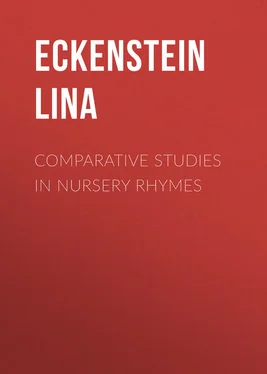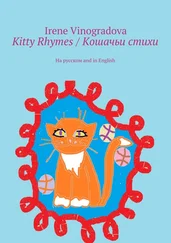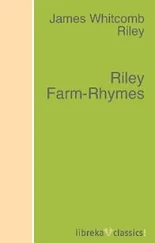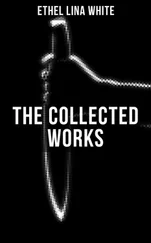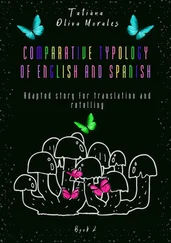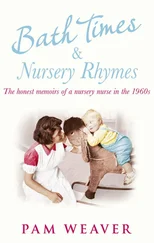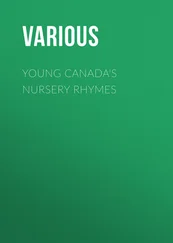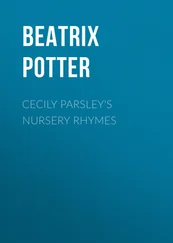Lina Eckenstein - Comparative Studies in Nursery Rhymes
Здесь есть возможность читать онлайн «Lina Eckenstein - Comparative Studies in Nursery Rhymes» — ознакомительный отрывок электронной книги совершенно бесплатно, а после прочтения отрывка купить полную версию. В некоторых случаях можно слушать аудио, скачать через торрент в формате fb2 и присутствует краткое содержание. Жанр: foreign_antique, foreign_prose, на английском языке. Описание произведения, (предисловие) а так же отзывы посетителей доступны на портале библиотеки ЛибКат.
- Название:Comparative Studies in Nursery Rhymes
- Автор:
- Жанр:
- Год:неизвестен
- ISBN:нет данных
- Рейтинг книги:3 / 5. Голосов: 1
-
Избранное:Добавить в избранное
- Отзывы:
-
Ваша оценка:
- 60
- 1
- 2
- 3
- 4
- 5
Comparative Studies in Nursery Rhymes: краткое содержание, описание и аннотация
Предлагаем к чтению аннотацию, описание, краткое содержание или предисловие (зависит от того, что написал сам автор книги «Comparative Studies in Nursery Rhymes»). Если вы не нашли необходимую информацию о книге — напишите в комментариях, мы постараемся отыскать её.
Comparative Studies in Nursery Rhymes — читать онлайн ознакомительный отрывок
Ниже представлен текст книги, разбитый по страницам. Система сохранения места последней прочитанной страницы, позволяет с удобством читать онлайн бесплатно книгу «Comparative Studies in Nursery Rhymes», без необходимости каждый раз заново искать на чём Вы остановились. Поставьте закладку, и сможете в любой момент перейти на страницу, на которой закончили чтение.
Интервал:
Закладка:
A cat came fiddling out of the barn,
With a pair of bagpipes under her arm,
She could sing nothing but fiddle cum fee,
The mouse has married the humble bee;
Pipe, cat, dance, mouse;
We'll have a wedding in our good house.
The following variation of this verse occurs in the Nursery Songs published by Rusher: —
A cat came fiddling out of a barn,
With a pair of bagpipes under her arm,
She sang nothing but fiddle-de-dee,
Worried a mouse and a humble bee.
Puss began purring, mouse ran away,
And off the bee flew with a wild huzza!
In both cases the cat was fiddling, that is moving to instrumental music without the utterance of words, and called upon the others to do so while she played the pipes. Her association with an actual fiddle, however, is preserved in the following rhyme which I cite in two of its numerous variations: —
Sing hey diddle diddle, the cat and the fiddle,
The cow jump'd over the moon!
The little dog laughed to see such sport,
And the dish lick't up the spoon.
Sing hey diddle diddle, the cat and the fiddle,
The cow jumped over the moon;
The little dog laughed to see such craft,
And the dish ran away with the spoon.
This rhyme also refers to the revelry which accompanied a feast, probably the one of Twelfth Night also.
CHAPTER IV
RHYMES IN TOY-BOOKS
MANY of our longer nursery pieces first appeared in print in the diminutive toy-books already described, which represent so curious a development in the literature of the eighteenth century. These books were sometimes hawked about in one or more sheets, which were afterwards folded so as to form a booklet of sixteen, thirty-two, or sixty-four pages. Others were issued sewn and bound in brilliant covers, at a cost of as much as a shilling or eighteen pence. Usually each page contained one verse which was illustrated by an appropriate cut. In the toy-books which tell a consecutive story, the number of verses of the several pieces seem to have been curtailed or enlarged in order to fit the required size of the book.
It is in these toy-books that we first come across famous nursery pieces such as the Alphabet which begins: —
A was an Archer, who shot at a frog,
B was a blind man, and led by a dog … etc.
This first appeared in A Little Book for Little Children by T. W., sold at the Ring in Little Britain. It contains a portrait of Queen Anne, and probably goes back to the early part of the eighteenth century.
The Topbook of all , already mentioned, which is of about 1760, contains the oldest version that I have come across of the words used in playing The Gaping, Wide-mouthed, Waddling Frog , each verse of which is illustrated by a rough cut. Again, The Tragic Death of A, Apple Pie , which, as mentioned above, was cited as far back as 1671, forms the contents of a toy-book issued by J. Evans about the year 1791 at the price of a farthing. The Death and Burial of Cock Robin fills a toy-book which was published by J. Marshall, London, and again by Rusher at Banbury; both editions are undated. Again The Courtship, Marriage, and Picnic Dinner of Cock Robin and Jenny Wren form the contents of a toy-book dated 1810 and published by Harris, and The Life and Death of Jenny Wren appeared in a toy-book dated 1813, issued by J. Evans.
Another famous toy-book contained The Comic Adventures of Old Mother Hubbard and her Dog . This story was first issued in toy-book form by J. Harris, "successor to E. Newbery at the corner of St. Paul's Churchyard," probably at the beginning of 1806, at the cost of eighteen pence. A copy of the second edition, which mentions the date 1 May, 1806, is at the British Museum. It contains the words "to T. B. Esquire, M.P. county of XX, at whose suggestion and at whose house these notable sketches were first designed, this volume is with all suitable deference dedicated by his humble servant S. C. M." The coffin which is represented in one of the cuts in the book bears the initials S. C. M., and the date 1804. This inscribing of the author's initials on a coffin is quite in keeping with the tone of toy-book literature.
In October, 1805, J. Harris had published Whimsical Incidents, or the Power of Music, a poetic tale by a near relation of Old Mother Hubbard , which has little to recommend it, and contains nothing on the dog. On its first page stands a verse which figures independently as a nursery rhyme in some later collections: —
The cat was asleep by the side of the fire,
Her mistress snor'd loud as a pig,
When Jack took the fiddle by Jenny's desire,
And struck up a bit of a jig.
J. Harris also published in March, 1806, Pug's Visit, or the Disasters of Mr. Punch , a sequel to the Comic Adventures of Mother Hubbard and her Dog . This has a dedication framed in the same style, "To P. A. Esquire … by his humble servant W. F."
The success of the Comic Adventures of Mother Hubbard and her Dog was instantaneous and lasting. In The Courtship of Jenny Wren , which is dated 1810, while its cuts bear the date 1806, Parson Rook is represented carrying "Mother Hubbard's book," and a foot-note is added to the effect that "upwards of ten thousand copies of this celebrated work have been distributed in various parts of the country in a few months." The Comic Adventures were read all over London and in the provinces, both in the original and in pirated editions, of which I have seen copies issued by J. Evans of Long Lane, West Smithfield; by W. S. Johnson of 60 St. Martin's Lane; by J. Marshall of Aldermary Churchyard; and by others. A very diminutive toy-book containing verses of the tale of Mother Hubbard, illustrated with rough cuts, is on view at South Kensington Museum among the exhibits of A. Pearson. I do not know its publisher.
The Comic Adventures of Mother Hubbard are usually told in fourteen verses, which refer to the dame's going to the cupboard, to her going for bread, for a coffin, for tripe, beer, wine, fruit, a coat, a hat, a wig, shoes, hose, and linen. The story ends: —
The dame made a curtsey, the dog made a bow,
The dame said, "Your servant," the dog said "Bow-wow."
But some editions have an additional rhyme on the dame's going for fish; and the edition at South Kensington has the verse: —
Old Mother Hubbard sat down in a chair,
And danced her dog to a delicate air;
She went to the garden to buy him a pippin,
When she came back the dog was skipping.
In the edition of Rusher, instead of "the dog made a bow," we read "Prin and Puss made a bow."
In Halliwell's estimation the tale of Mother Hubbard and her dog is of some antiquity, "were we merely to judge," he says, "of the rhyme of laughing to coffin in the third verse."
She went to the undertaker's to buy him a coffin,
When she came back the poor dog was laughing.
But it seems possible also that the author of the poem had running in his mind a verse containing this rhyme, which occurs already in the Infant Institutes of 1797, where it stands as follows: —
There was a little old woman and she liv'd in a shoe,
She had so many children, she didn't know what to do.
She crumm'd 'em some porridge without any bread
And she borrow'd a beetle, and she knock'd 'em all o' th' head.
Then out went the old woman to bespeak 'em a coffin
And when she came back she found 'em all a-loffing.
Интервал:
Закладка:
Похожие книги на «Comparative Studies in Nursery Rhymes»
Представляем Вашему вниманию похожие книги на «Comparative Studies in Nursery Rhymes» списком для выбора. Мы отобрали схожую по названию и смыслу литературу в надежде предоставить читателям больше вариантов отыскать новые, интересные, ещё непрочитанные произведения.
Обсуждение, отзывы о книге «Comparative Studies in Nursery Rhymes» и просто собственные мнения читателей. Оставьте ваши комментарии, напишите, что Вы думаете о произведении, его смысле или главных героях. Укажите что конкретно понравилось, а что нет, и почему Вы так считаете.
